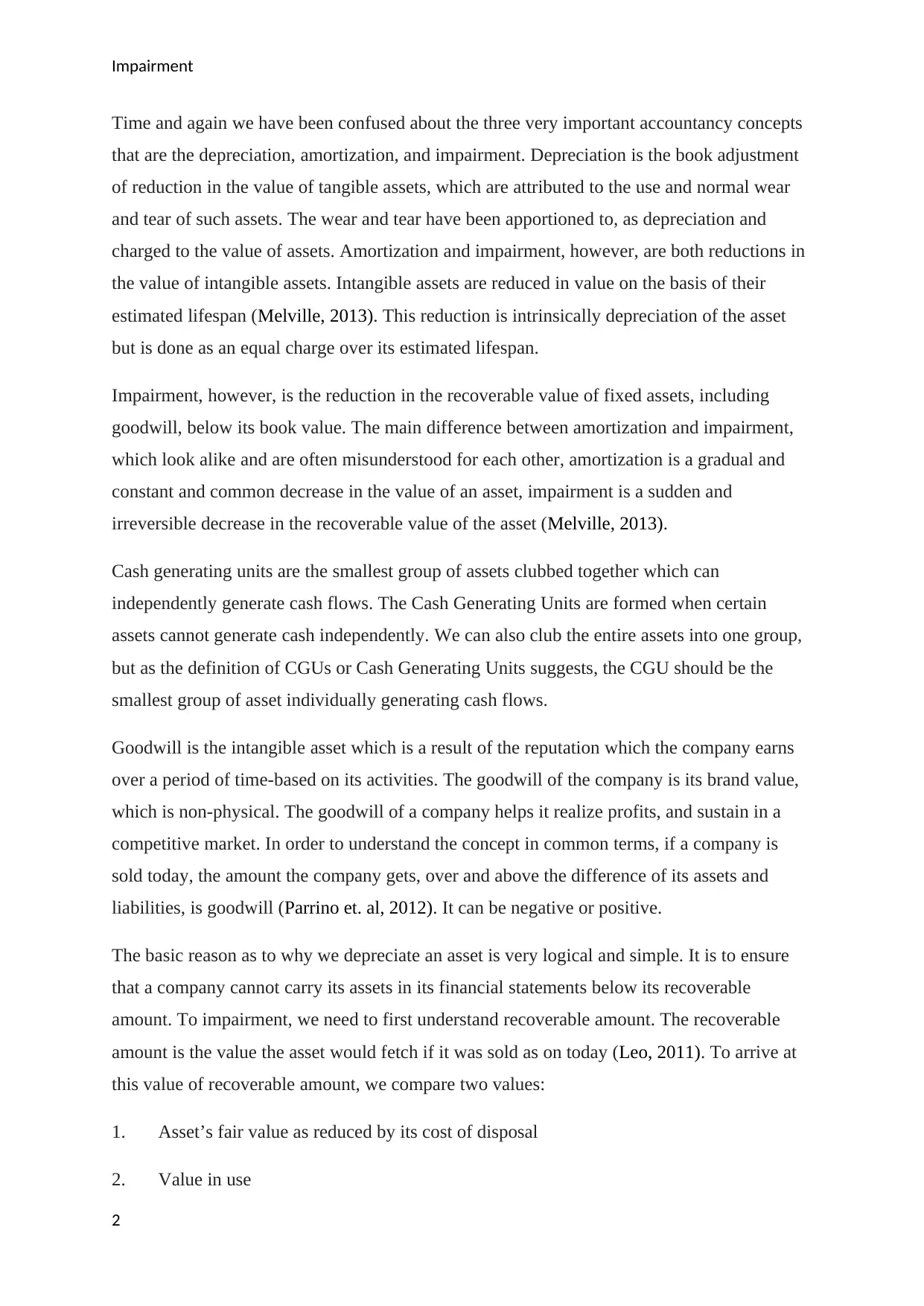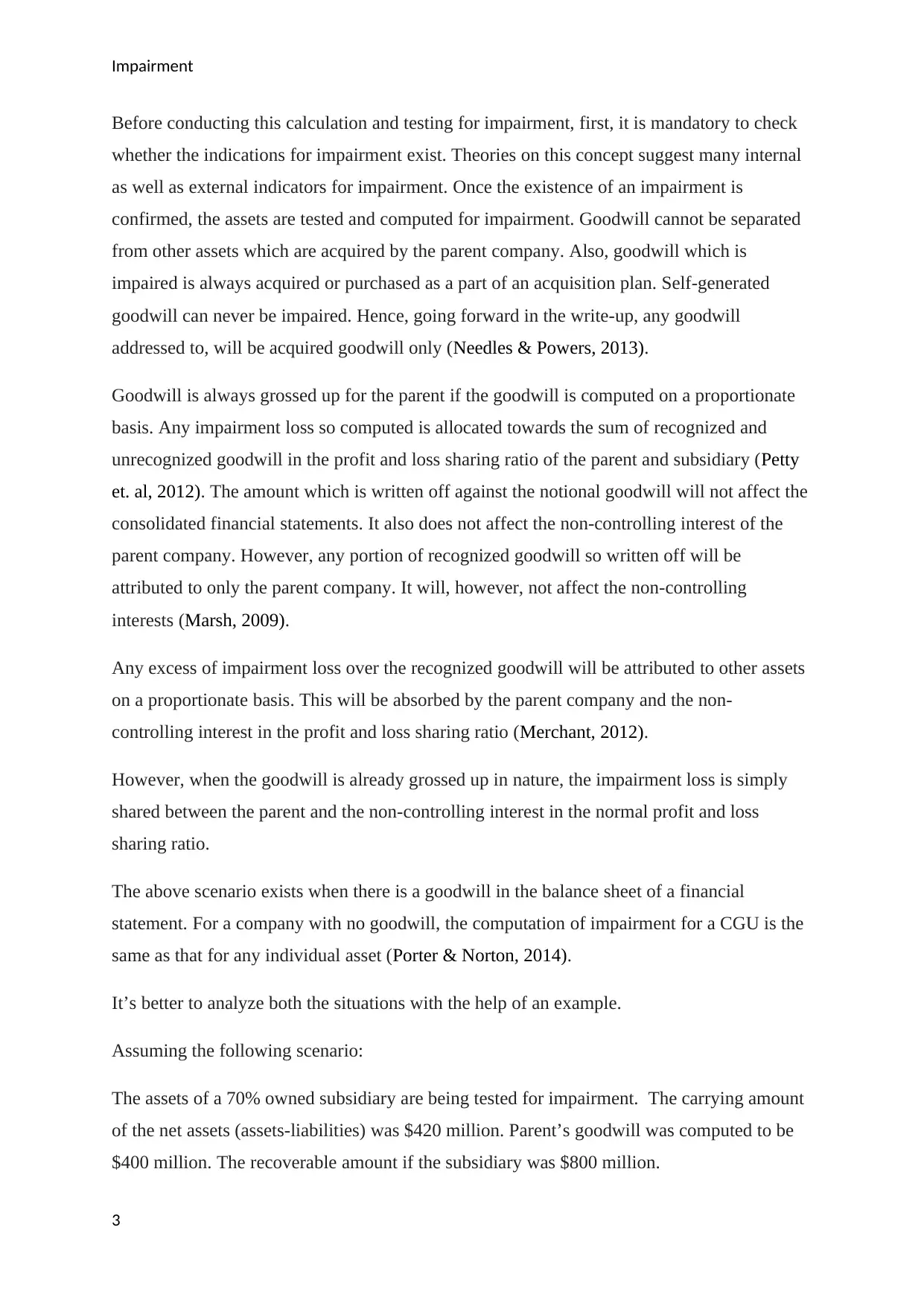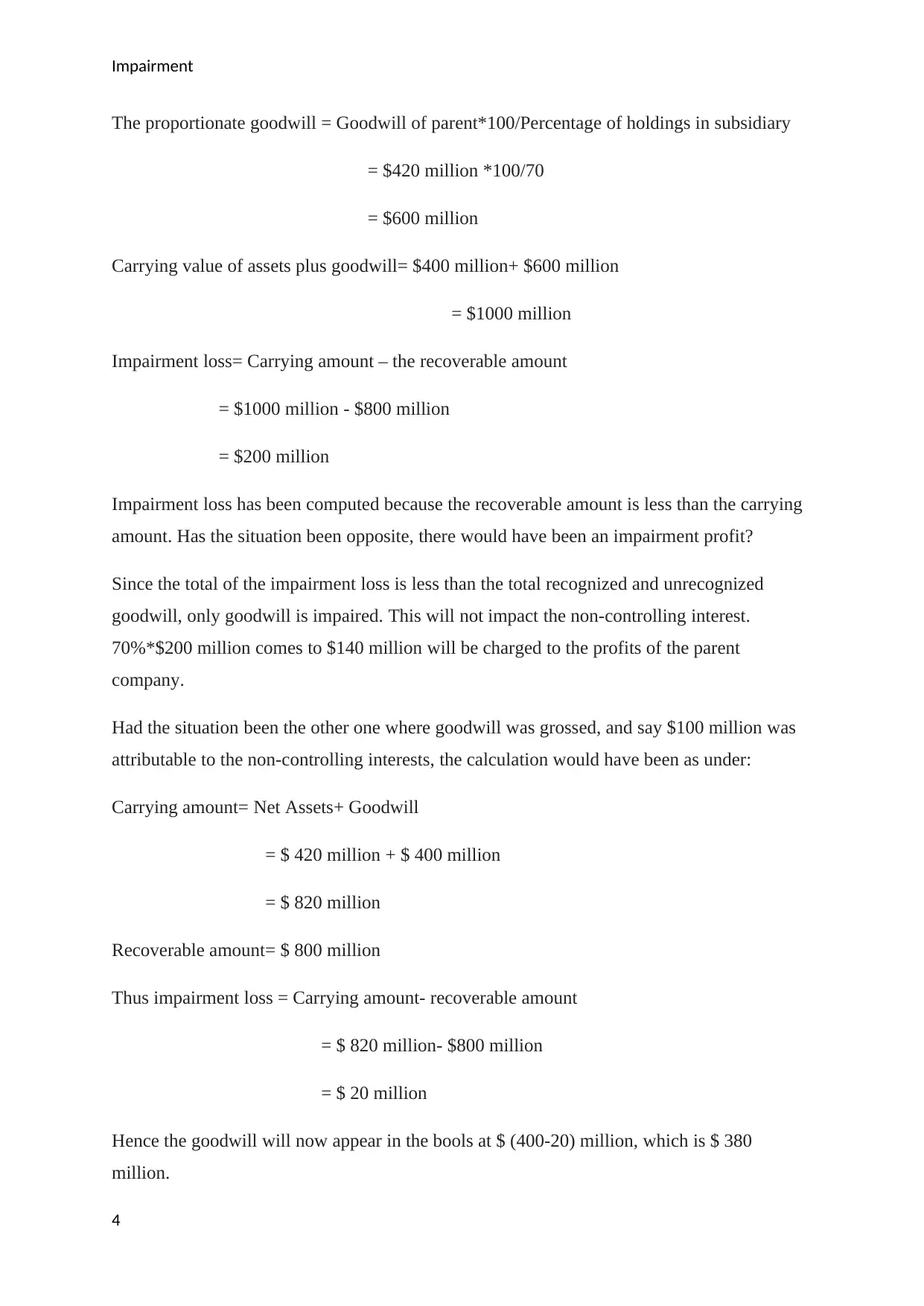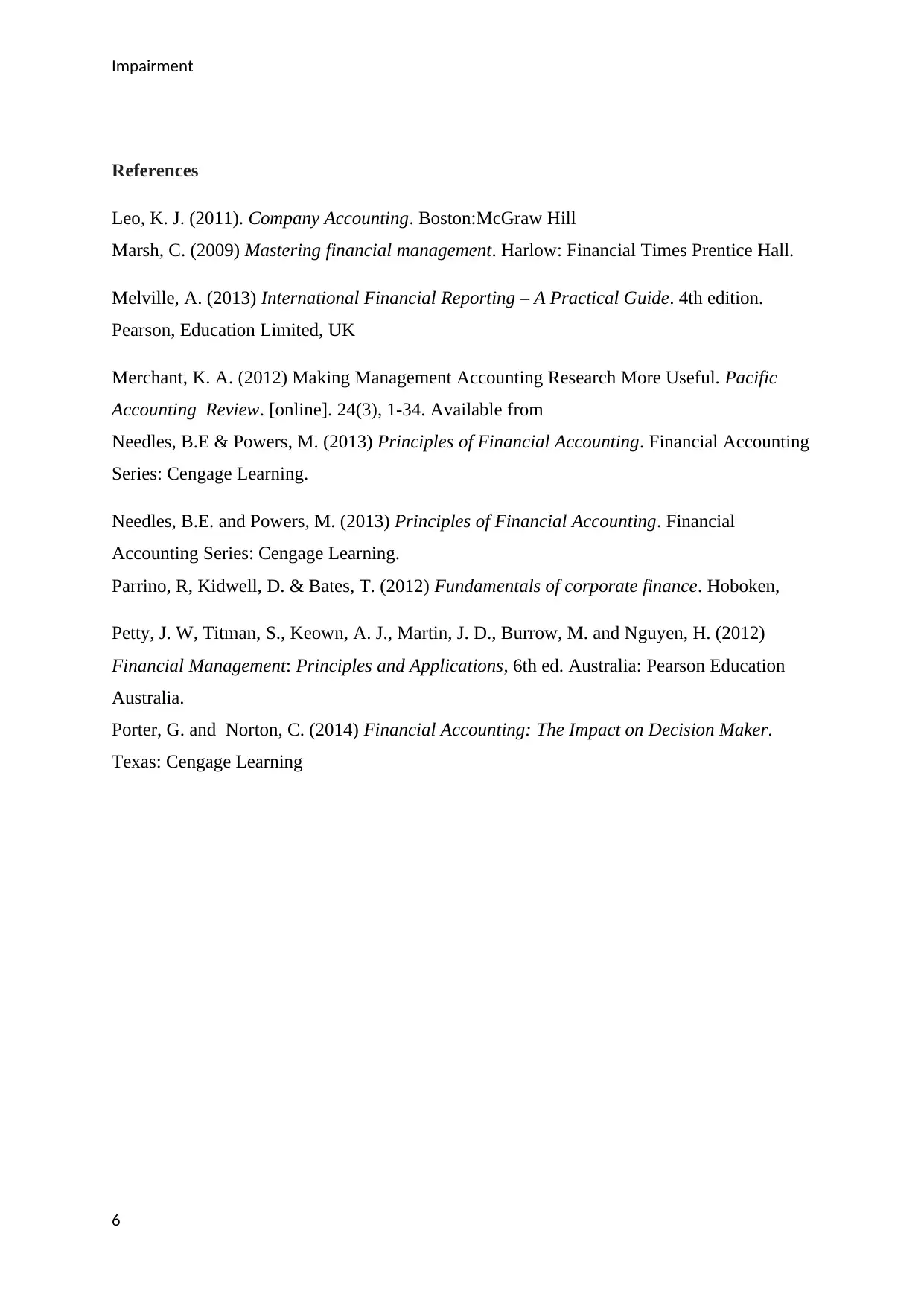Corporate Accounting: Depreciation, Amortization, Impairment
VerifiedAdded on 2021/06/18
|6
|1471
|23
Report
AI Summary
This report delves into the crucial accounting concepts of depreciation, amortization, and impairment. It clarifies the distinctions between these terms, emphasizing that depreciation pertains to tangible assets, while amortization and impairment relate to intangible assets. The report explains how amortization is a gradual value reduction over an asset's lifespan, while impairment represents a sudden decrease in recoverable value. It further discusses cash-generating units and goodwill, an intangible asset reflecting a company's brand value. The core reason for depreciation is to ensure assets are not carried on financial statements below their recoverable amount, which is determined by comparing fair value less disposal costs and value in use. The report explains the process for computing and testing for impairment, including the role of goodwill and its treatment in impairment calculations, especially in scenarios involving subsidiaries and non-controlling interests. The report includes an example to illustrate how impairment losses are computed and allocated, considering scenarios with and without grossed-up goodwill. Finally, the report provides several references to support the concepts discussed.

qwertyuiopasdfghjklzxcvbnmqwerty
uiopasdfghjklzxcvbnmqwertyuiopasd
fghjklzxcvbnmqwertyuiopasdfghjklzx
cvbnmqwertyuiopasdfghjklzxcvbnmq
wertyuiopasdfghjklzxcvbnmqwertyui
opasdfghjklzxcvbnmqwertyuiopasdfg
hjklzxcvbnmqwertyuiopasdfghjklzxc
vbnmqwertyuiopasdfghjklzxcvbnmq
wertyuiopasdfghjklzxcvbnmqwertyui
opasdfghjklzxcvbnmqwertyuiopasdfg
hjklzxcvbnmqwertyuiopasdfghjklzxc
vbnmqwertyuiopasdfghjklzxcvbnmq
wertyuiopasdfghjklzxcvbnmqwertyui
opasdfghjklzxcvbnmqwertyuiopasdfg
hjklzxcvbnmrtyuiopasdfghjklzxcvbn
mqwertyuiopasdfghjklzxcvbnmqwert
yuiopasdfghjklzxcvbnmqwertyuiopas
corporate accounting and reporting
uiopasdfghjklzxcvbnmqwertyuiopasd
fghjklzxcvbnmqwertyuiopasdfghjklzx
cvbnmqwertyuiopasdfghjklzxcvbnmq
wertyuiopasdfghjklzxcvbnmqwertyui
opasdfghjklzxcvbnmqwertyuiopasdfg
hjklzxcvbnmqwertyuiopasdfghjklzxc
vbnmqwertyuiopasdfghjklzxcvbnmq
wertyuiopasdfghjklzxcvbnmqwertyui
opasdfghjklzxcvbnmqwertyuiopasdfg
hjklzxcvbnmqwertyuiopasdfghjklzxc
vbnmqwertyuiopasdfghjklzxcvbnmq
wertyuiopasdfghjklzxcvbnmqwertyui
opasdfghjklzxcvbnmqwertyuiopasdfg
hjklzxcvbnmrtyuiopasdfghjklzxcvbn
mqwertyuiopasdfghjklzxcvbnmqwert
yuiopasdfghjklzxcvbnmqwertyuiopas
corporate accounting and reporting
Paraphrase This Document
Need a fresh take? Get an instant paraphrase of this document with our AI Paraphraser

Impairment
Time and again we have been confused about the three very important accountancy concepts
that are the depreciation, amortization, and impairment. Depreciation is the book adjustment
of reduction in the value of tangible assets, which are attributed to the use and normal wear
and tear of such assets. The wear and tear have been apportioned to, as depreciation and
charged to the value of assets. Amortization and impairment, however, are both reductions in
the value of intangible assets. Intangible assets are reduced in value on the basis of their
estimated lifespan (Melville, 2013). This reduction is intrinsically depreciation of the asset
but is done as an equal charge over its estimated lifespan.
Impairment, however, is the reduction in the recoverable value of fixed assets, including
goodwill, below its book value. The main difference between amortization and impairment,
which look alike and are often misunderstood for each other, amortization is a gradual and
constant and common decrease in the value of an asset, impairment is a sudden and
irreversible decrease in the recoverable value of the asset (Melville, 2013).
Cash generating units are the smallest group of assets clubbed together which can
independently generate cash flows. The Cash Generating Units are formed when certain
assets cannot generate cash independently. We can also club the entire assets into one group,
but as the definition of CGUs or Cash Generating Units suggests, the CGU should be the
smallest group of asset individually generating cash flows.
Goodwill is the intangible asset which is a result of the reputation which the company earns
over a period of time-based on its activities. The goodwill of the company is its brand value,
which is non-physical. The goodwill of a company helps it realize profits, and sustain in a
competitive market. In order to understand the concept in common terms, if a company is
sold today, the amount the company gets, over and above the difference of its assets and
liabilities, is goodwill (Parrino et. al, 2012). It can be negative or positive.
The basic reason as to why we depreciate an asset is very logical and simple. It is to ensure
that a company cannot carry its assets in its financial statements below its recoverable
amount. To impairment, we need to first understand recoverable amount. The recoverable
amount is the value the asset would fetch if it was sold as on today (Leo, 2011). To arrive at
this value of recoverable amount, we compare two values:
1. Asset’s fair value as reduced by its cost of disposal
2. Value in use
2
Time and again we have been confused about the three very important accountancy concepts
that are the depreciation, amortization, and impairment. Depreciation is the book adjustment
of reduction in the value of tangible assets, which are attributed to the use and normal wear
and tear of such assets. The wear and tear have been apportioned to, as depreciation and
charged to the value of assets. Amortization and impairment, however, are both reductions in
the value of intangible assets. Intangible assets are reduced in value on the basis of their
estimated lifespan (Melville, 2013). This reduction is intrinsically depreciation of the asset
but is done as an equal charge over its estimated lifespan.
Impairment, however, is the reduction in the recoverable value of fixed assets, including
goodwill, below its book value. The main difference between amortization and impairment,
which look alike and are often misunderstood for each other, amortization is a gradual and
constant and common decrease in the value of an asset, impairment is a sudden and
irreversible decrease in the recoverable value of the asset (Melville, 2013).
Cash generating units are the smallest group of assets clubbed together which can
independently generate cash flows. The Cash Generating Units are formed when certain
assets cannot generate cash independently. We can also club the entire assets into one group,
but as the definition of CGUs or Cash Generating Units suggests, the CGU should be the
smallest group of asset individually generating cash flows.
Goodwill is the intangible asset which is a result of the reputation which the company earns
over a period of time-based on its activities. The goodwill of the company is its brand value,
which is non-physical. The goodwill of a company helps it realize profits, and sustain in a
competitive market. In order to understand the concept in common terms, if a company is
sold today, the amount the company gets, over and above the difference of its assets and
liabilities, is goodwill (Parrino et. al, 2012). It can be negative or positive.
The basic reason as to why we depreciate an asset is very logical and simple. It is to ensure
that a company cannot carry its assets in its financial statements below its recoverable
amount. To impairment, we need to first understand recoverable amount. The recoverable
amount is the value the asset would fetch if it was sold as on today (Leo, 2011). To arrive at
this value of recoverable amount, we compare two values:
1. Asset’s fair value as reduced by its cost of disposal
2. Value in use
2

Impairment
Before conducting this calculation and testing for impairment, first, it is mandatory to check
whether the indications for impairment exist. Theories on this concept suggest many internal
as well as external indicators for impairment. Once the existence of an impairment is
confirmed, the assets are tested and computed for impairment. Goodwill cannot be separated
from other assets which are acquired by the parent company. Also, goodwill which is
impaired is always acquired or purchased as a part of an acquisition plan. Self-generated
goodwill can never be impaired. Hence, going forward in the write-up, any goodwill
addressed to, will be acquired goodwill only (Needles & Powers, 2013).
Goodwill is always grossed up for the parent if the goodwill is computed on a proportionate
basis. Any impairment loss so computed is allocated towards the sum of recognized and
unrecognized goodwill in the profit and loss sharing ratio of the parent and subsidiary (Petty
et. al, 2012). The amount which is written off against the notional goodwill will not affect the
consolidated financial statements. It also does not affect the non-controlling interest of the
parent company. However, any portion of recognized goodwill so written off will be
attributed to only the parent company. It will, however, not affect the non-controlling
interests (Marsh, 2009).
Any excess of impairment loss over the recognized goodwill will be attributed to other assets
on a proportionate basis. This will be absorbed by the parent company and the non-
controlling interest in the profit and loss sharing ratio (Merchant, 2012).
However, when the goodwill is already grossed up in nature, the impairment loss is simply
shared between the parent and the non-controlling interest in the normal profit and loss
sharing ratio.
The above scenario exists when there is a goodwill in the balance sheet of a financial
statement. For a company with no goodwill, the computation of impairment for a CGU is the
same as that for any individual asset (Porter & Norton, 2014).
It’s better to analyze both the situations with the help of an example.
Assuming the following scenario:
The assets of a 70% owned subsidiary are being tested for impairment. The carrying amount
of the net assets (assets-liabilities) was $420 million. Parent’s goodwill was computed to be
$400 million. The recoverable amount if the subsidiary was $800 million.
3
Before conducting this calculation and testing for impairment, first, it is mandatory to check
whether the indications for impairment exist. Theories on this concept suggest many internal
as well as external indicators for impairment. Once the existence of an impairment is
confirmed, the assets are tested and computed for impairment. Goodwill cannot be separated
from other assets which are acquired by the parent company. Also, goodwill which is
impaired is always acquired or purchased as a part of an acquisition plan. Self-generated
goodwill can never be impaired. Hence, going forward in the write-up, any goodwill
addressed to, will be acquired goodwill only (Needles & Powers, 2013).
Goodwill is always grossed up for the parent if the goodwill is computed on a proportionate
basis. Any impairment loss so computed is allocated towards the sum of recognized and
unrecognized goodwill in the profit and loss sharing ratio of the parent and subsidiary (Petty
et. al, 2012). The amount which is written off against the notional goodwill will not affect the
consolidated financial statements. It also does not affect the non-controlling interest of the
parent company. However, any portion of recognized goodwill so written off will be
attributed to only the parent company. It will, however, not affect the non-controlling
interests (Marsh, 2009).
Any excess of impairment loss over the recognized goodwill will be attributed to other assets
on a proportionate basis. This will be absorbed by the parent company and the non-
controlling interest in the profit and loss sharing ratio (Merchant, 2012).
However, when the goodwill is already grossed up in nature, the impairment loss is simply
shared between the parent and the non-controlling interest in the normal profit and loss
sharing ratio.
The above scenario exists when there is a goodwill in the balance sheet of a financial
statement. For a company with no goodwill, the computation of impairment for a CGU is the
same as that for any individual asset (Porter & Norton, 2014).
It’s better to analyze both the situations with the help of an example.
Assuming the following scenario:
The assets of a 70% owned subsidiary are being tested for impairment. The carrying amount
of the net assets (assets-liabilities) was $420 million. Parent’s goodwill was computed to be
$400 million. The recoverable amount if the subsidiary was $800 million.
3
⊘ This is a preview!⊘
Do you want full access?
Subscribe today to unlock all pages.

Trusted by 1+ million students worldwide

Impairment
The proportionate goodwill = Goodwill of parent*100/Percentage of holdings in subsidiary
= $420 million *100/70
= $600 million
Carrying value of assets plus goodwill= $400 million+ $600 million
= $1000 million
Impairment loss= Carrying amount – the recoverable amount
= $1000 million - $800 million
= $200 million
Impairment loss has been computed because the recoverable amount is less than the carrying
amount. Has the situation been opposite, there would have been an impairment profit?
Since the total of the impairment loss is less than the total recognized and unrecognized
goodwill, only goodwill is impaired. This will not impact the non-controlling interest.
70%*$200 million comes to $140 million will be charged to the profits of the parent
company.
Had the situation been the other one where goodwill was grossed, and say $100 million was
attributable to the non-controlling interests, the calculation would have been as under:
Carrying amount= Net Assets+ Goodwill
= $ 420 million + $ 400 million
= $ 820 million
Recoverable amount= $ 800 million
Thus impairment loss = Carrying amount- recoverable amount
= $ 820 million- $800 million
= $ 20 million
Hence the goodwill will now appear in the bools at $ (400-20) million, which is $ 380
million.
4
The proportionate goodwill = Goodwill of parent*100/Percentage of holdings in subsidiary
= $420 million *100/70
= $600 million
Carrying value of assets plus goodwill= $400 million+ $600 million
= $1000 million
Impairment loss= Carrying amount – the recoverable amount
= $1000 million - $800 million
= $200 million
Impairment loss has been computed because the recoverable amount is less than the carrying
amount. Has the situation been opposite, there would have been an impairment profit?
Since the total of the impairment loss is less than the total recognized and unrecognized
goodwill, only goodwill is impaired. This will not impact the non-controlling interest.
70%*$200 million comes to $140 million will be charged to the profits of the parent
company.
Had the situation been the other one where goodwill was grossed, and say $100 million was
attributable to the non-controlling interests, the calculation would have been as under:
Carrying amount= Net Assets+ Goodwill
= $ 420 million + $ 400 million
= $ 820 million
Recoverable amount= $ 800 million
Thus impairment loss = Carrying amount- recoverable amount
= $ 820 million- $800 million
= $ 20 million
Hence the goodwill will now appear in the bools at $ (400-20) million, which is $ 380
million.
4
Paraphrase This Document
Need a fresh take? Get an instant paraphrase of this document with our AI Paraphraser

Impairment
The loss will be shared by the parent and the NCI ( Non-controlling interest) in the ratio of
70%: 30%.
5
The loss will be shared by the parent and the NCI ( Non-controlling interest) in the ratio of
70%: 30%.
5

Impairment
References
Leo, K. J. (2011). Company Accounting. Boston:McGraw Hill
Marsh, C. (2009) Mastering financial management. Harlow: Financial Times Prentice Hall.
Melville, A. (2013) International Financial Reporting – A Practical Guide. 4th edition.
Pearson, Education Limited, UK
Merchant, K. A. (2012) Making Management Accounting Research More Useful. Pacific
Accounting Review. [online]. 24(3), 1-34. Available from
Needles, B.E & Powers, M. (2013) Principles of Financial Accounting. Financial Accounting
Series: Cengage Learning.
Needles, B.E. and Powers, M. (2013) Principles of Financial Accounting. Financial
Accounting Series: Cengage Learning.
Parrino, R, Kidwell, D. & Bates, T. (2012) Fundamentals of corporate finance. Hoboken,
Petty, J. W, Titman, S., Keown, A. J., Martin, J. D., Burrow, M. and Nguyen, H. (2012)
Financial Management: Principles and Applications, 6th ed. Australia: Pearson Education
Australia.
Porter, G. and Norton, C. (2014) Financial Accounting: The Impact on Decision Maker.
Texas: Cengage Learning
6
References
Leo, K. J. (2011). Company Accounting. Boston:McGraw Hill
Marsh, C. (2009) Mastering financial management. Harlow: Financial Times Prentice Hall.
Melville, A. (2013) International Financial Reporting – A Practical Guide. 4th edition.
Pearson, Education Limited, UK
Merchant, K. A. (2012) Making Management Accounting Research More Useful. Pacific
Accounting Review. [online]. 24(3), 1-34. Available from
Needles, B.E & Powers, M. (2013) Principles of Financial Accounting. Financial Accounting
Series: Cengage Learning.
Needles, B.E. and Powers, M. (2013) Principles of Financial Accounting. Financial
Accounting Series: Cengage Learning.
Parrino, R, Kidwell, D. & Bates, T. (2012) Fundamentals of corporate finance. Hoboken,
Petty, J. W, Titman, S., Keown, A. J., Martin, J. D., Burrow, M. and Nguyen, H. (2012)
Financial Management: Principles and Applications, 6th ed. Australia: Pearson Education
Australia.
Porter, G. and Norton, C. (2014) Financial Accounting: The Impact on Decision Maker.
Texas: Cengage Learning
6
⊘ This is a preview!⊘
Do you want full access?
Subscribe today to unlock all pages.

Trusted by 1+ million students worldwide
1 out of 6
Related Documents
Your All-in-One AI-Powered Toolkit for Academic Success.
+13062052269
info@desklib.com
Available 24*7 on WhatsApp / Email
![[object Object]](/_next/static/media/star-bottom.7253800d.svg)
Unlock your academic potential
Copyright © 2020–2025 A2Z Services. All Rights Reserved. Developed and managed by ZUCOL.




